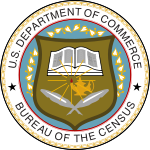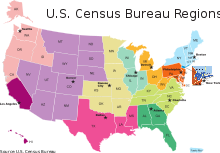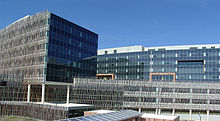- United States Census Bureau
-
Bureau of the Census 
Seal 
Logo Agency overview Formed July 1, 1903 Preceding agency Temporary census offices Headquarters Suitland, Maryland Employees 5,593 (2006) Annual budget US$3.1 billion (2009)
US$7.2 billion (est. 2010)
US$1.3 billion (est. 2011)Agency executive Director, Robert Groves Parent agency Economics and Statistics Administration Website www.census.gov The United States Census Bureau (officially the Bureau of the Census, as defined in Title ) is the government agency that is responsible for the United States Census. It also gathers other national demographic and economic data. As part of the United States Department of Commerce, the Census Bureau serves as a leading source of data about America's people and economy.[1]
The most visible role of the Census Bureau is to perform the official decennial (every 10 years) count of people living in the U.S. The most important result is the reallocation of the number of seats each state is allowed in the House of Representatives,[1] but the results also affect a range of government programs received by each state. The agency director is a political appointee selected by the President of the United States.
Contents
Legal mandate
The Constitution of the United States (Article I, section II) directs that the population be enumerated at least once every ten years and the resulting counts used to set the number of members from each state in the House of Representatives and, by extension, in the Electoral College. The Census Bureau now conducts a full population count every 10 years in years ending with a 0 (zero) and uses the term "decennial" to describe the operation. Between censuses, the Census Bureau makes population estimates and projections.[2] In addition, Census data directly affects how more than $400 billion per year in federal and state funding is allocated to communities for neighborhood improvements, public health, education, transportation and much more. The Census Bureau is mandated with fulfilling these obligations: the collecting of statistics about the nation, its people, and economy. The Census Bureau's legal authority is codified in Title 13 of the United States Code. In addition, the Census Bureau also conducts surveys on behalf of various federal government and local government agencies on topics such as employment, crime, health, consumer expenditures, and housing. Within the bureau, these are known as "demographic surveys" and are conducted perpetually between and during decennial (10-year) population counts. The Census Bureau also conducts economic surveys of manufacturing, retail, service, and other establishments and of domestic governments.
From 1790 to 1840, the census was taken by marshals of the judicial districts.[3] The Census Act of 1840 established a central office[4] which became known as the Census Office. Several acts followed that revised and authorized new censuses, typically at the 10-year intervals. In 1902 the temporary Census Office was moved under the Department of Interior, and in 1903 it was renamed the Census Bureau under the new Department of Commerce and Labor. The department was intended to consolidate overlapping statistical agencies, but Census Bureau officials were hindered by their subordinate role in the department.[5] An act in 1920 changed the date and authorized manufacturing censuses every 2 years and agriculture censuses every 10 years.[6] In 1929, a bill was passed mandating that the House of Representatives be reapportioned based on the results of the 1930 Census.[6] In 1954, various acts were codified into Title 13 of the US Code.[7]
By law the Census Bureau must count everyone and submit state population totals to the U.S. President by December 31, 2010. States within the Union receive the results in the spring of the following year.
Uses of census data
Many federal, state, local and tribal governments use census data to:
- Decide the location of new housing and public facilities,
- Examine the demographic characteristics of communities, states, and the USA,
- Plan transportation systems and roadways,
- Determine quotas and creation of police and fire precincts, and
- Create localized areas for elections, schools, utilities, etc.
Businesses
Business also has many uses for census data, as listed;
- Forecast future product demand,
- Determine site locations for expansion/new business,
- Determine future need for nursing homes, day care centers, hospitals, etc.,
- Clarify if they are employing a representative workforce.[1]
Data stewardship
The United States Census Bureau is committed to confidentiality and guarantees non-disclosure of any addresses or personal information related to individuals or establishments. Title 13 of the U.S. Code establishes penalties for the disclosure of this information. All Census employees must sign a sworn affidavit of non-disclosure prior to employment.
The Bureau cannot share responses, addresses or personal information with anyone including United States or foreign government and law enforcement agencies such as the IRS or the FBI or Interpol. "Providing quality data, for public good—while respecting individual privacy and, at the same time, protecting confidentiality—is the Census Bureau's core responsibility", "Keeping the public's trust is critical to the Census's ability to carry out the mission as the leading source of quality data about the Nation's people and economy."[8] Only after 72 years does the information collected become available to other agencies or the general public.
In 1918, the Census Bureau released individual information regarding several hundred young men to the Justice Department and Selective Service system for the purpose of prosecutions for draft evasion.[9][10] During World War II, the United States Census Bureau assisted the government's Japanese American internment efforts by providing confidential neighborhood information on Japanese-Americans. The Bureau's role was denied for decades but was finally proven in 2007.[11][12]
Organizational structure
Since 1903, the official census-taking agency of the United States government has been the Bureau of the Census. The Census Bureau is headed by a Director, assisted by a Deputy Director and an Executive Staff composed of the associate directors. In April 2009, President Barack Obama nominated Robert M. Groves to head the Census Bureau.
The Census Bureau has had headquarters in Suitland, Maryland since 1942. A new headquarters complex was completed in 2007 and supports over 4,000 employees.[13] The Bureau operates regional offices in 12 cities: Boston, New York City, Philadelphia, Detroit, Chicago, Kansas City, Seattle, Charlotte, Atlanta, Dallas, Denver, and Los Angeles. The National Processing Center is located in Jeffersonville, Indiana. Additional temporary processing facilities are used to facilitate the decennial census, which employs more than a million people. The cost of the 2000 Census was $4.5 billion. During the years just prior to the decennial census, parallel census offices, known as "Regional Census Centers" are opened in the field office cities. The decennial operations are carried out from these facilities. The Regional Census Centers l oversee the openings and closings of smaller "Local Census Offices" within their collection jurisdictions. The estimated cost of the 2010 Census is $14.7 billion.
The Census Bureau also runs the Census Information Center cooperative program that involves 58 "national, regional, and local non-profit organizations." The CIC program aims to represent the interests of underserved communities.[14]
Census regions and divisions
The United States Census Bureau has four official regions, with nine official divisions.
Computer equipment
 A card puncher, part of the tabulation system used to compile the thousands of facts gathered by the Bureau. Holes are punched in the card according to a prearranged code transferring the facts from the census questionaire into statistics.
A card puncher, part of the tabulation system used to compile the thousands of facts gathered by the Bureau. Holes are punched in the card according to a prearranged code transferring the facts from the census questionaire into statistics.
The 1890 census was the first to use the electric tabulating machines invented by Herman Hollerith.[15][16] For 1890-1940 details, see Truesdell, Leon E. (1965). The Development of Punch Card Tabulation in the Bureau of the Census, 1890-1940: With outlines of actual tabulation programs. US GPO. In 1946, knowing of the Bureau's funding of Hollerith and, later, Powers, John Mauchly approached the Bureau about early funding for UNIVAC development.[17] A UNIVAC I computer was accepted by the Bureau in 1951.[18]
In order to reduce paper usage and reduce payroll expenses, 500,000 handheld computers (HHC's) were used for the first time in 2009 during the address canvassing portion of the 2010 Decennial Census Project. Projected savings are over one billion dollars.[19] The further implementation of advanced computer systems in the planning for the 2020 census provides major challenges for an upgrade in the technological broadening of census protocol.
Ongoing surveys
A survey is a method of collecting and analyzing social, economic, and geographic data. It provides information about the conditions of the United States, states, and counties. Throughout the decade between censuses, the bureau is conducts surveys to produce a general view and comprehensive study of the United States' social and economic conditions.
Staff from the Current Surveys Program conduct ongoing and special surveys about people and their characteristics. A network of professional field representatives gathers information from a sample of households, responding to questions about employment, consumer expenditures, health, housing, and other topics.
Surveys conducted between decades:
- American Community Survey
- Consumer Expenditure Survey
- Census of Governments
- Current Population Survey
- Economic Census
- National Hospital Discharge Survey
- National Health Interview Survey
- National Hospital Ambulatory Medical Care Survey
- National Crime Victimization Survey
- National Ambulatory Medical Care Survey (NAMCS)
- National Nursing Home Survey
- Survey of Income and Program Participation
- Survey of Construction
- Survey of Market Absorption
- Survey of Program Dynamics
- National Longitudinal Survey
- National Survey of Fishing, Hunting, & Wildlife-Associated Recreation 2001
- American Housing Survey
- Residential Finance Survey
- National Epidemiologic Survey of Alcohol Related Conditions
- Annual Retail Trade Survey
- Annual Wholesale Trade Survey
- Annual and Quarterly Services Surveys
Other surveys conducted
The Census Bureau collects information in many other surveys and provides the data to the survey sponsor for release. These sponsors include:
- Bureau of Justice Statistics (BJS)
- Bureau of Labor Statistics (BLS)
- Bureau of Transportation Statistics (BTS)
- Department of Housing and Urban Development (HUD)
- National Center for Education Statistics (NCES)
- National Center for Health Statistics (NCHS)
- National Science Foundation (NSF)
- Social Security Administration (SSA)
Notes
- ^ a b c USCB DOC-D1026 QVC Manual 01/03/09
- ^ "Census Population Estimates". U.S. Bureau of the Census. http://www.census.gov/popest/estimates.php.
- ^ History 1790. US Census Bureau.
- ^ History 1840. US Census Bureau.
- ^ History: 1900 Overview. US Census Bureau.
- ^ a b History 1920. US Census Bureau.
- ^ History 1954. US Census Bureau.
- ^ Census Employee Handbook, April 2009, http://www.census.gov/po/www/foia/D590.pdf
- ^ The Myth of Census Confidentiality, 8, Amerasia Journal, UCLA Asian American Studies Center Press, Fall/Winter 1981, pp. 111–120, ISSN 0044-7471, http://aascpress.metapress.com/content/jk115283m54v4313/
- ^ David Kopel (May 4, 1990), Census Confidentiality? The Check's is in the Mail, Cato Institute, http://www.cato.org/pub_display.php?pub_id=8938
- ^ JR Minkel (March 30, 2007), Confirmed: The U.S. Census Bureau Gave Up Names of Japanese-Americans in WW II, Scientific American, http://www.scientificamerican.com/article.cfm?id=confirmed-the-us-census-b&sc=I100322
- ^ Haya El Nasser (March 30, 2007), Papers show Census role in WWII camps, USA Today, http://www.usatoday.com/news/nation/2007-03-30-census-role_N.htm
- ^ Census.gov
- ^ "Census Information Centers". U.S. Bureau of the Census. http://www.census.gov/clo/www/cic/. Retrieved 2008-05-13.
- ^ Herman Hollerith
- ^ History 1890 US Census Bureau.
- ^ Stern, Nancy (1981). From ENIAC to UNIVAC: An appraisal of the Eckert-Mauchly Computers. Digital Press. ISBN 0-932376-14-2.
- ^ Bashe, Charles J.; et. al (1986). IBM's Early Computers. MIT. ISBN 0-262-02225-7.
- ^ Govcomm.harris.com
References
- The original version of, and subsequent additions to, this article were adapted from U.S. Census Bureau text.
- Geographic Areas Reference Manual from the U.S. Census Bureau contains detailed explanations of geographic terms used in the census.
- The mission and operation of the U.S. Census Bureau are laid out in Title 13 of the United States Code.
External links
- Official website
- U.S. and World Population Clocks – POPClocks
- Works by Bureau of the Census at Project Gutenberg
- Census Bureau Meeting Notices and Rule Changes from The Federal Register RSS Feed
- Proposed and finalized federal regulations from the United States Census Bureau
United States Censuses (Census Bureau) 
Geographic regions of the United States Political Units U.S. state · District of Columbia · Insular area · Minor Outlying Island · Maritime territory
Time zones Census West (Pacific · Mountain) · Midwest (E N Central · W N Central) · Northeast (New England · Middle Atlantic) · South (S Atlantic · E S Central · W S Central)
Federal Judicial circuits Physical Physiographic Pacific Mountain · Intermontane Plateaus · Rocky Mountain · Superior Upland · Interior Plains · Interior Highlands · Appalachian · Atlantic Plain
Coastal Arctic · West · Great Lakes · Gulf · East
Historical Ac/cessions Civil War Theaters (Pacific · Western · Trans-Mississippi · Lower Seaboard · Eastern) · Union (Border states) · Confederacy (Old South · Dixie · Slave states)
Other Appalachia · Central · Four Corners · Great Plains · High Plains · Intermountain · Interior · Northwest Territory · South Central · Southern (Deep · New · Upland) · Southeast · Southwest
Categories Belts · Broadcast · Census-designated places · Counties · Cuisine (wine) · Divided (Columbia–Oregon–Pacific NW · Prairie Pothole) · Panhandles
Statistical agencies of the United States Federal Government Department of Labor Department of Commerce Department of Energy Department of Agriculture Department of Transportation Department of Justice Department of Defense Department of Education Department of Housing and Urban Development Department of Homeland Security Department of Health and Human Services Categories:- United States Census Bureau
- National statistical services
- Government agencies established in 1903
- Organizations based in Washington, D.C.
- Decennial federal censuses of the United States
- Statistical organizations in the United States
- 1903 establishments in the United States
Wikimedia Foundation. 2010.



